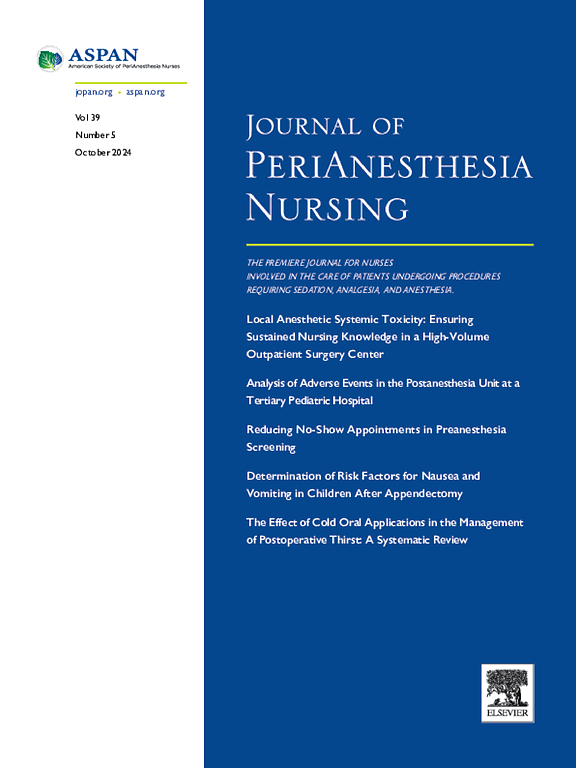Sugar Low When NPO? Patient Variables Associated With Pediatric Preoperative Hypoglycemia
IF 2
4区 医学
Q2 NURSING
引用次数: 0
Abstract
Purpose
To identify the demographic variables and patient factors associated with pediatric patients treated for preoperative hypoglycemia at a large urban pediatric hospital.
Design
Retrospective chart review.
Methods
Chart reviews were completed for known cases of preoperative hypoglycemia. The study team evaluated each case of hypoglycemia for the presence or absence of 10 variables including age, gender, weight percentile, fasting duration for solids and clear liquids, time of day of hypoglycemic event, American Society of Anesthesiology status, surgical service, presence or absence of preoperative bowel cleanout, presence or absence of intraoperative complications, and prior history of diabetes or hypoglycemia. When comparison data were available, a comparison was made to the hospital’s general surgical population.
Findings
There were no statistically significant differences found between the frequency distributions of the general surgical population and the hypoglycemic population with regard to race (P = .211), gender (P = .3139), and incidence of intraoperative complications (P < .0813). However, the hypoglycemic population was different from the general population (P < .05) in the areas of age, American Society of Anesthesiology status, history of diabetes or hypoglycemia, frequency of gastrointestinal or pulmonary procedures, and time of day of the hypoglycemic event. In addition, trends were identified in the hypoglycemia population with regard to body weight, completion of preoperative bowel cleanout, and duration of fasting. These differences and trends could indicate risk factors for preoperative hypoglycemia.
Conclusions
This study identified several potential risk factors for pediatric preoperative hypoglycemia; however, the study was limited by its retrospective nature. More research is needed to confirm these risk factors and identify any others.
NPO 时血糖过低?与小儿术前低血糖相关的患者变量。
目的:在一家大型城市儿科医院中,确定与接受术前低血糖治疗的儿科患者相关的人口统计学变量和患者因素:设计:回顾性病历审查:方法:对已知的术前低血糖病例进行病历回顾。研究小组对每例低血糖病例是否存在 10 个变量进行了评估,包括年龄、性别、体重百分位数、禁食固体和透明液体的时间、低血糖事件发生的时间、美国麻醉学会状态、手术服务、术前是否清肠、术中是否出现并发症以及既往糖尿病史或低血糖史。如果有比较数据,则与医院的普通手术人群进行比较:结果:在种族(P = .211)、性别(P = .3139)和术中并发症发生率(P 结论:普通手术人群和低血糖人群的频率分布之间没有统计学意义上的差异:本研究确定了儿科术前低血糖症的几个潜在风险因素;但是,本研究具有回顾性,因此受到了限制。需要进行更多的研究来确认这些风险因素并找出其他风险因素。
本文章由计算机程序翻译,如有差异,请以英文原文为准。
求助全文
约1分钟内获得全文
求助全文
来源期刊

Journal of Perianesthesia Nursing
NURSING-
CiteScore
2.20
自引率
17.60%
发文量
279
审稿时长
90 days
期刊介绍:
The Journal of PeriAnesthesia Nursing provides original, peer-reviewed research for a primary audience that includes nurses in perianesthesia settings, including ambulatory surgery, preadmission testing, postanesthesia care (Phases I and II), extended observation, and pain management. The Journal provides a forum for sharing professional knowledge and experience relating to management, ethics, legislation, research, and other aspects of perianesthesia nursing.
 求助内容:
求助内容: 应助结果提醒方式:
应助结果提醒方式:


